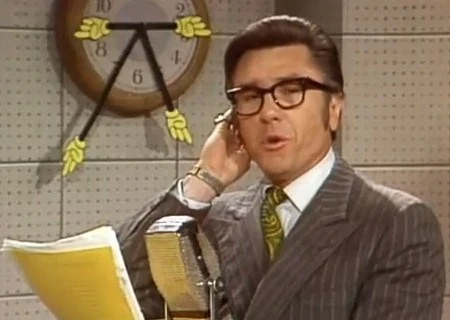This is true for interview guests, advertising clients who do their own commercials, it seems especially true for podcast hosts, and maybe it was even true for you.
In all the years I spent doing morning radio, it was something that in-studios guests would virtually always need coaching on – from people who ran local charitable organizations to veteran actors who’d appeared on Broadway stages. And, like so many things with so many of my coaching clients over the years, it’s something that you can just let go of – unless no one has ever pointed it out to you before. So consider this conversation as the moment someone pointed it out to you, and then in theory you’ll never have to think about it again.
It goes back to the early days of radio. I’m not talking about all the way back to Walter Winchell, I’m thinking more of “the glory days” of rock & roll radio. I’m thinking of legends like Gary Owens, Robert W. Morgan, The Real Don Steele, and in later days people like Rick Dees and Shadoe Stevens.
Those jocks all had one thing in common: That really big radio voice. I grew up listening to the radio in Toronto, where we had guys like Tom Rivers, John Landecker and Mike Cooper, all who built careers on being able to say things “1050 CHUM” and finishing the call letters just as the singer was starting to sing. Fun sidebar: Back in the day, we used to call that “hitting the vocal” – now that’s not to be confused with “hitting the post“. The post was some kind of musical highlight that happened in the intro before the singer came in.
For example: One of my favorite songs for “hitting the post” was the 1983 classic from The Tubes called, “She’s A Beauty”.
There are a million posts here, but the BEST ones are about 5.4 seconds in (when the guitar starts), at about 14 seconds (when the drums first come in), and then the vocal at about 22. And the 45s would actually have little white stickers on them marked with, in this example, “5.5, 14, 22-V”, all to help the DJ figure out exactly where to make his super-big voice shine.

Thankfully, somewhere around the 1990s, that started to change, and stations started to value what was being said and considering it at least as important as how it sounded. By the way, that’s one of the pet peeves I have with the occasional podcast client who will want to talk to me for an hour about their choice of microphone, and whether they should spend $600 for this one or $450 for that one, and are hesitant to invest a similar amount of time agonizing over the quality of their content. SPOILER ALERT: Your crappy show is going to sound just as crappy on a $1700 microphone as it will on one you picked up for $30 at a yard sale.
But even though the reality was changing, and the big voice DJ was less and less dominant on the radio, the image remained. As soon as you invite someone to talk like an announcer, they get that big radio DJ sound in their voice, everybody shares a laugh and we move on.
Fast-forward, though, until the day when you’re on the other side of the glass. You’ve been invited onto a local radio show. A TV network calls and asks for your expert commentary on a news item. Somebody asks if you’ll be a guest on their podcast. Or maybe you’re starting your own podcast.
Suddenly, I’d say around seventy or eighty percent of people I’ve run into suffer from a devastatingly quick and completely unnecessary version of Imposter Syndrome. You can almost see the thought in their head, like the little cloud over Peter Parker’s head when he noticed his Spidey senses were tingling. What are they thinking? “How am I possibly going to be on television? I don’t look like a TV person.” Or, “Why on Earth am I going to be on the radio? I don’t sound like a DJ.”
Typically, based on what I’ve seen, one of two things happens in this situation: The paralytic fear of not sounding and looking like a broadcaster has a negative impact on the appearance, and the person walks away from the experience thinking they looked or sounded stupid, and they don’t ever want to do it again. Or – and this one is common among podcast hosts – the fear is less of a factor than just tacit acceptance that people who talk into a microphone are just supposed to sound that way, that’s just what you’re supposed to do. And they end up sounding less than genuine, the audience picks up on that, and the ripple effects down the road can hurt a show’s future.
The whole thing could have been avoided with one very simple conversation. And like I said off the top, you and I are going to have this conversation right now, and then we never have to have it again.
Unless you actually are a professional broadcaster, stop trying to sound like one and look like one. Showing up in a chef’s coat isn’t going to get you three Michelin stars for your taco stand. So instead, just sound like you. If you’ve been invited into the studio to be part of the commercial for your business, don’t worry about sounding like the announcer, focus on sounding like the person who the customers are used to talking to. You know… you. If the TV people have asked you to share your expertise on cryptocurrency, don’t worry about looking like a news anchor, focus on being an expert about crypto. If you’re starting a podcast about Star Wars, stop worrying about trying to imitate what it would sound like if Morgan Freeman were a Star Wars fan and instead, focus on sounding like you.
Here’s how I know this will help you. If you go and listen to the audio version of this episode by clicking on the player up top, you’ll quickly realize that I’m reading this article as thought it were a script. And if you and I sit down for a meeting, or if you’re one of my coaching clients and we’re on a Zoom call, you’ll very quickly realize that what you’re hearing right now is my natural speaking voice. I write the script to fit my voice, and to suit my delivery. Now, if I’m doing a radio show and The Tubes come on, you might hear me get a little more animated while I tell you that it’s 74 degrees in the sunshine and the high today is 92, but it’s a slightly more energetic version of this, because I’m into the rhythm of the song that’s playing under my voice. Same as it would be different again if I was doing that same weather forecast over the intro of “Stairway To Heaven” which, by the way, is verboten. Don’t do it. Don’t ever do it. If you’ve ever done it, we can’t be friends. Talking over the intro of “Stairway To Heaven” is on a list of forbidden things like touching the art at the museum, or putting Baby in a corner. Just don’t. The point is, you’ll never catch me doing any of that big voice guy stuff, because I’m not a big voice guy. I’m just me. I’m on that massive list of broadcasters who would never have had jobs if the quality of your voice were still the most important thing. I mean, come on. Let’s be honest. Sean Hannity’s voice sounds like seven cats fighting in a burlap sack. But he’s got fourteen million listeners.
The bottom line is this: Once you’ve stopped worrying about being the professional broadcaster version of you, you suddenly free up what my old friend David Allen refers to as “psychic RAM”. You get to just be you. You’ll suddenly be surprised at how you never forget to work in the important stuff you really wanted to say, and how by being you, you seemed to be more comfortable and by being more comfortable you seemed more… professional.






